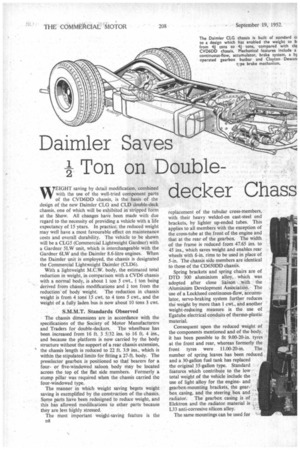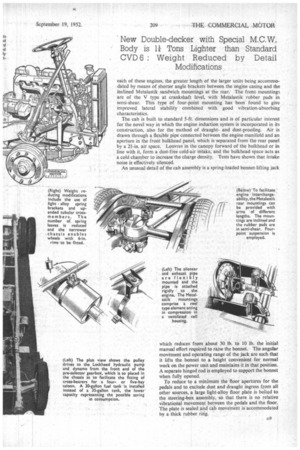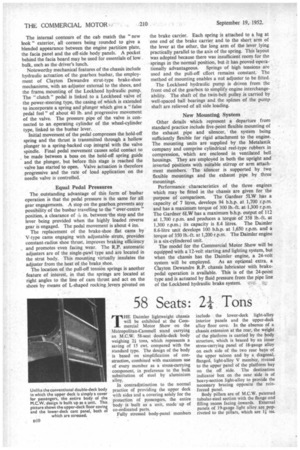Daimler Saves Ton on Double decker Chass
Page 82

Page 83

Page 84

If you've noticed an error in this article please click here to report it so we can fix it.
WEIGHT saving by detail modification, combined with the use of the well-tried component parts of the CVD6DD chassis, is the basis of the design of the new Daimler CLG and CLD double-deck chassis, one of which will be exhibited in stripped form at the Show. All changes have been made with due regard to the necessity of providing a vehicle with a life expectancy of 15 years. In practice, the reduced weight may well have a most favourable effect on maintenance costs and overall durability. The vehicle to be shown will be a CLG5 (Commercial Lightweight Gardner) with a Gardner 5LVV unit, which is interchangeable with the Gardner 6LW and the Daimler 8.6-litre engines. When the Daimler unit is employed, the chassis is designated the Commercial Lightweight Daimler (CLD6).
With a lightweight M.C.W. body, the estimated total reduction in weight, in comparison with a CVD6 chassis with a normal body, is about 1 ton 5 cwt., i ton being derived from chassis modifications and 1 ton from the reduction of body weight. •The reduction in chassis weight is from 4 tong 15 cwt. to 4 tons 5 cwt., and the weight of a fully laden bus is now about 10 tons 3 cwt.
S.M.M.T. Standards Observed The chassis dimensions are in accordance with the specifications of the Society of Motor Manufacturers and Traders for double-deckers. The wheelbase has been increased from 16 ft. 3 5/32 ins. to 16 ft. 4 ins., and because the platform is now carried by the body structure without the support of a rear chassis extension, ' the chassis length is reduced to 22 ft. 3.9 ins., which is within the stipulated limits for fitting a 27-ft. body. The preselector gearbox is positioned so that bearers for a fouror five-windowed saloon body may be located across the top of the flat side members. Formerly a stump pillar was required when the chassis carried the four-windowed type.
The manner in which weight saving begets weight saving is exemplified by the construction of the chassis. Some parts have been redesigned to reduce weight, and this has allowed modifications to other parts because they are less highly stressed.
The most important weight-saving feature is the replacement of the tubular cross-members, with their heavy welded-on cast-steel end brackets, by lighter up-ended tubes. This applies to all members with the exception of the cross-tube at the front of the engine and that at the rear of the gearbox. The width of the frame is reduced from 47.65 ins. to 45 ins., which saves weight and enables rear wheels with 6-in, rims to be used in place of 5-in. The chassis side members are identical to those of the CD650DD chassis.
Spring brackets and spring chairs are of D'TD 300 aluminium alloy, which was adopted after close liaison with the Aluminium Development Association. The use of a Lockheed continuous-flow, accumulator, servo-braking system further reduces the weight by more than 1 cwt., and another weight-reducing measure is the use of Egatube electrical conduits of thermo-plastic material.
Consequent upon the reduced weight of the components mentioned and of the body, it has been possible to fit 9.00-20-in. tyres at the front and rear, whereas formerly the front tyres were 11.00-20-in. The number of spring leaves has been reduced and a 30-gallon fuel tank has replaced the original 35-gallon type. Standard features which contribute to the low total weight of the vehicle include the use of light alloy for the engineand gearbox-mounting brackets, the gearbox casing, and the steering box and radiator. The gearbox casing is of Elektron and the radiator material is L33 anti-corrosive silicon alloy.
The same mountings can be used for each of these engines, the greater length of the larger units being accommodated by means of shorter angle brackets between. the• engine casing and the inclined Metalastik sandwich mountings at the rear. The front mountings are of the V type at crankshaft level, with Metalastik rubber pads in semi-shear. This type of four-point mounting has been found to give improved lateral stability combined with good vibration-absorbing characteristics.
The cab is built to standard 5-ft. dimensions and is of particular interest for the novel way in which the engine induction system is incorporated in its construction, also for the method of draughtand dust-proofing. Air is drawn through a flexible pipe connected between the engine manifold and an aperture in the front bulkhead panel, which is-separated from the rear panel by a 21-in, air space. Louvres in the canopy forward of the bulkhead or in line with it, form a dust-free cold-air intake, and the bulkhead space acts as a cold chamber to increase the charge density. Tests have shown that intake noise is effectively silenced.
An unusual detail of the cab assembly is a spring-loaded bonnet-lifting jack which reduces from about 30 lb. to 10 lb. the initial manual effort required to raise the bonnet. The angular movement and operating range of the jack are such that it lifts the bonnet to a height convenient for normal work on the power unit and maintains it in that position. A separate hinged rod is employed to support the bonnet when fully opened.
To reduce to a minimum the floor apertures for the pedals and to exclude dust and draught ingress from all other sources, a large light-alloy floor plate is bolted to the steering-box assembly, so that there is no relative vibrational movement between the pedals and the floor. The plate is sealed and cab movement is accommodated by a thick rubber ring. The internal contours of the cab match the "new look" exterior, all corners being rounded to give a blended appearance between the engine partition plate, the facia panel and the off-side body panels. A pocket behind the facia board may be used for essentials of low bulk, such as the driver's lunch.
Noteworthy mechanical features of the chassis include hydraulic actuation of the gearbox busbar, the employment of Clayton Dewandre strut-type brake-shoe mechanisms, with an adjuster external to the shoes, and the frame, mounting of the Lockheed hydraulic pump. The " clutch " pedal is linked to a Lockheed valve of the power-steering type, the casing of which is extended to incorporate a spring and plunger which give a "false pedal feel" of about 40 lb. and progressive movement of the valve. The pressure pipe of the valve is connected to an operating cylinder of the wheel-cylinder type, linked to the busbar lever.
Initial movement of the pedal compresses the hold-off spring and the thrust is transmitted through a hollow plunger to a spring-backed cup integral with the valve spindle. Final pedal movement causes solid contact to , be made between a boss on the hold-off spring guide and the plunger, but before this stage is reached the valve has started to open. Valve actuation is therefore progressive and the rate of load application on the needle valve is controlled.
Equal Pedal Pressures The outstanding advantage of this form of busbar operation is that the pedal pressure is the same for all gear engagements. A stop on the gearbox prevents any possibility of the busbar travelling to the " over-centre " position, a clearance of A in. between-the stop and the lever being provided when the highly loaded reverse gear is engaged. The pedal movement is about 4 ins.
The replacement of the brake-shoe flat cams by V-type cams engaging with adjustable struts, provides constant-radius shoe thrust, improves braking efficiency and promotes even facing wear. The R.P. automatic adjusters are of the single-pawl type and are located in the strut body. This mounting virtually insulates the adjuster from the heat of the brake shoe.
The location of the pull-off tension springs is another feature of interest, in that the springs are located at right angles to the line of cam thrust and act on the shoes by means of L-shaped rocking levers pivoted on the brake carrier. Each spring is attached to a lug at one end of the brake carrier and to the short arm of the lever at the other, the long arm of the lever lying practically parallel to the axis of the spring. This layout was adopted because there was insufficient room for the springs in the normal position, but it has proved operationally advantageous. Springs of high tensions are used and the pull-off effort remains constant. The method of mounting enables a nut adjuster to be fitted.
The Lockheed hydraulic pump is driven from the front end of the gearbox to simplify engine interchangeability. The shaft of the twin-belt pulley is carried by well-spaced ball bearings and the splines of the pump shaft are relieved of all side loading.
New Mounting System
Other details which represent a departure from standard practice include five-point flexible mounting of the exhaust pipe and silencer, the system being sufficiently flexible for rigid attachment to the engine. The mounting units are supplied by the Metalastik company and comprise cylindrical reel-type rubbers in compression, which are enclosed in ventilated bell housings. They are employed in both the upright and inverted positions with suitable stirrup or arm attachment members. The silencer is supported by two flexible mountings and the exhaust pipe by three mountings.
Performance characteristics of the three engines which may be fitted in the chassis are given for the purpose of comparison. The Gardner 5LW has a capacity of 7 litres, develops 94 b.h.p. at 1,700 r.p.m. and has a maximum torque of 300 lb.-ft. at 1,300 r.p.m. The Gardner 6LW has a maximum b.h.p. output of 112 at 1,700 r.p.m. and produces a torque of 358 lb.-ft. at 1,300 r.p.m.; its capacity is 8.4 litres. The Daimler 8.6-litre unit develops 100 b.h.p. at 1,650 r.p.m. and a torque of 350 lb.-ft. at 1,200 r.p.m. The Daimler engine is a six-cylindered unit.
The model for the Commercial Motor Show will be equipped with a 12-volt starting and lighting system, but when the chassis has the Daintier engine, a 24-volt system will be employed. As an optional extra, a Clayton Dewandre R.P. chassis lubricator with brake. pedal operation is available. This is of the 24-point type and is actuated by fluid pressure from the pipe line of the Lockheed hydraulic brake system. ,n




































































































































































